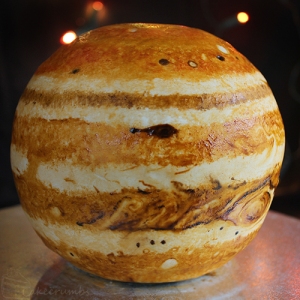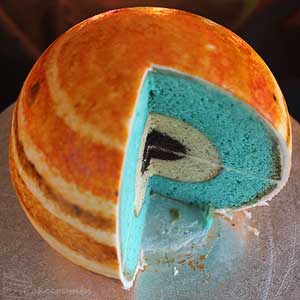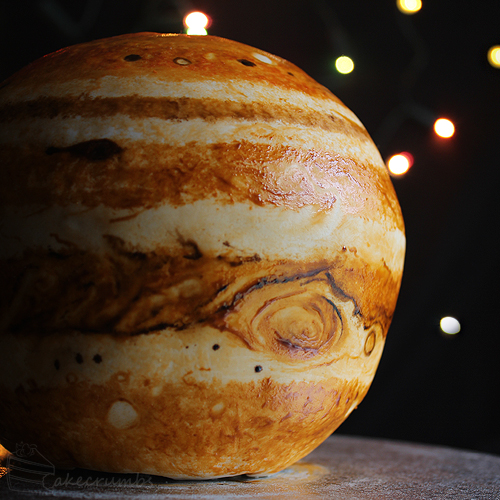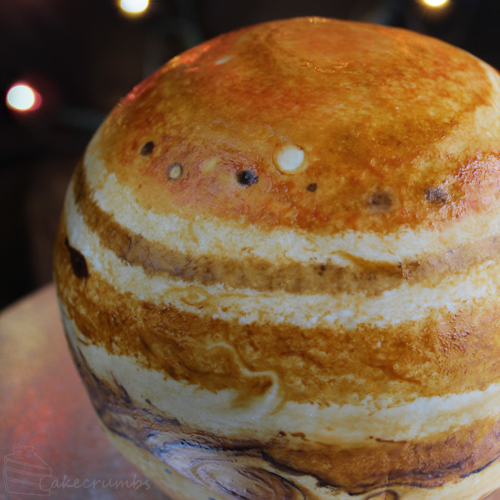By cakecrumbs.me:
When I posted the Earth cake, I did not expect it to get anywhere near the amount of attention it received. Getting featured on the Facebook pages Think Geek and I Fucking Love Science was a total highlight of my blogging life. I’m big fans of both pages so it was kind of surreal. A lot of my Zoology graduate mates are also fans of IFLS and you’d often hear conversations in the Masters office beginning with, “Did you see that post by IFLS today?” So I woke up to several of them messaging me about it and we all got super excited over it.
With the exposure those pages brought came a whole lot of people who wanted to know how to make it. I still get a couple of emails a week asking for a recipe. The cake was a total experiment on my part, and not one that went flawlessly. There were many imperfections within the cake and I never share recipes unless I know it’s absolutely tried and true. I’d hate to be responsible for a baking fail simply for giving a botched up recipe. But I also hate letting people down. So I decided to re-visit the concept so I could make a tutorial. That will come later in the week as I’m still editing it. But first, here’s the result of round 2.
One question I got asked a lot was if it was possible to make it a sphere. Absolutely it is. If you can make the hemisphere a sphere is easy. I didn’t want to make another Earth cake as I hate repeating bakes, so I opted to decorate it as something new. I threw around a few ideas ranging from something floral to a giant pokéball, but in the end I just wanted to make another planet.
Choosing a favourite planet was tough. As a kid I was fiercely passionate about two things: animals and the solar system. I ended up following the path of the former and never kept up to date with the latter, but the inner passion for astronomy has never died. Space is just so freaking cool. Our solar system alone is filled with so many fascinating planets, dwarf planets and all their satellites — choosing just one felt treacherous.
In the end I settled on Jupiter predominantly for one reason: its Great Red Spot. The giant anticyclonic storm has always been one of my favourite things and continues to be a subject of great fascination for me. At thrice the size of the Earth it’s bewildering to comprehend the actual magnitude of it. If I absolutely have to choose a favourite planet, it’s got to Jupiter for that storm alone. It’s also so iconic. It’s a characteristic feature almost everyone is familiar with, making it easier to create something that would be instantly recognisable.
The red spot is one of a number of storms you can see all over Jupiter. Some of them last hours, others last for centuries. The red spot had been around since the early 1800s, and it’s possible that it may remain as a permanent feature of the planet. It would be fascinating to see Jupiter if the storm did in fact die out, or if another large one were to appear. The smaller white storms are made up of cool clouds in the upper atmosphere, whereas the brown dots are composed of warmer clouds in the lower atmosphere.
I detailed the atmosphere of Jupiter by covering the cake with ivory marshmallow fondant, then dry brushing a combination of ivory, brown and maroon edible ink. The top ended up being a bit more saturated as I was largely experimenting with colours at that point and was throwing in a bit of yellow. I ended up sticking mostly with ivory and adding extra detail with the brown. Once all the base colours were down I started removing colour to create the storms or other distinguishing features and topping it off with highlights. The whole process took about 8 hours with teeny tiny brushes.
Here’s a 360 of the cake:




It was kind of difficult to get good reference shots of the non-red-spot sides of Jupiter, particularly to get consistent ones. They were all taken over many different years and influenced by many different weather events so there was lots of variation. But I got enough to get a rough guestimate of the more static features of Jupiter’s atmosphere. The rest I’ll just claim as artistic license.
Finally came time to cut the cake and see how there spheres lined up inside. It turned out better matched than I’d anticipated.
When my sister asked me what I was making and I said Jupiter, she said to me, “I didn’t even know Jupiter had layers.” It’s amazing how much we can forget after learning it in primary school. So here’s a rehashing for those of you who’ve also forgotten. Our knowledge is mostly theoretical of course, but the gas giants are thought to have a core comprised mostly of rock and ice. This is surrounded by a layer liquid metallic hydrogen, and the outer layer is composed of molecular hydrogen. *cake is totally not to scale
In cake speak, this translates to a core made of mudcake, surrounded by almond butter cake, surrounded by a tinted vanilla Madeira sponge. There’s a crumb coat of vanilla buttercream underneath the fondant.
This run went so much better than the first, informed by the mistakes and lessons learned in the mean time. So I feel much safer sharing the process with you guys now. Stay tuned for that later this week if all goes to plan.










